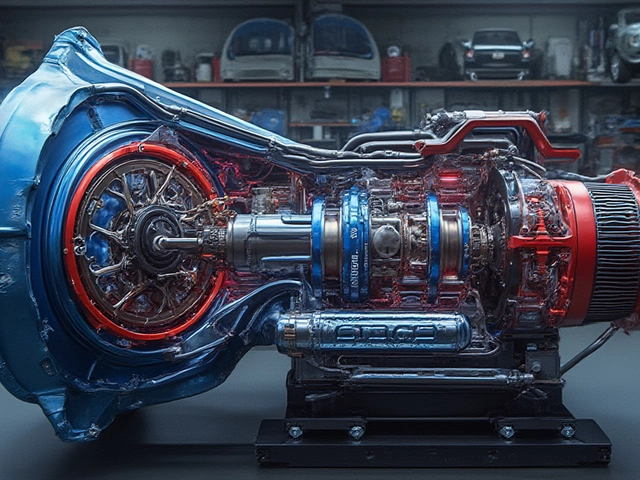Ever wonder why your engine suddenly feels rough, like your car is trying to run with a cold or maybe even a hangover? That jittery idle, sluggish acceleration, and those ominous dashboard lights aren’t just bad luck—they’re usually a symptom of spark plugs gone rogue. People often treat spark plugs like boring background players, but here’s the truth: they’re the all-stars that keep your engine alive. When one or more of these little guys gives up, chaos is waiting to crash the party under your hood. Engines don’t forgive dying spark plugs, and the signs show up in ways most drivers just can’t ignore.
How Spark Plugs Actually Work—And Why They're Crucial
Spark plugs have a pretty unsung job, but they’re nothing short of a miracle worker each and every second you drive. They shoot out a spark—think of it as a mini bolt of lightning—across a precise gap every time your engine cycles. That little spark sets off an explosion in the air-fuel mix inside each cylinder, making the pistons move, turning that energy into the power rolling your wheels. It happens thousands of times per minute. When spark plugs are fresh and healthy, you get smooth starts, even acceleration, and decent fuel mileage. The moment they start going south? Everything changes.
The science here is simple but powerful: that spark needs to stay strong, precise, and perfectly timed. Over thousands of miles, residues from gas and oil build up on the plug tips. Electrodes wear down. Gaps widen ever so slightly. Tiny flaws add up. If the spark becomes weak, late, or inconsistent, the air-fuel mix won’t burn like it should. Suddenly, those controlled explosions become, well, uncontrolled sputters. Not so fun anymore.
Modern engines—think pretty much everything built after 2000—lean heavily on their spark plugs to meet stricter emission standards and squeak out every last bit of horsepower and fuel savings. Even minor delays or weak sparks send all sorts of alarms to the car’s computer brain. Data from a CarMD study found that failed spark plugs rank in the top five causes of that dreaded “check engine” light popping on. You can thank your engine for being so sensitive, and spark plugs for being absolutely mission-critical.
Symptoms and Warning Signs: When Spark Plugs Start to Go Bad
If your engine develops a cough or feels unusually gutless, it’s no accident. Bad spark plugs are notorious for causing abrupt and dramatic changes in performance. Rough idling tops the list: instead of that sleepy purr, your car now clatters or vibrates at red lights. Engine misfires aren’t just a dramatic term from mechanic lingo—they’re real, loud, and hard to miss. The car jerks, shakes, even hesitates whenever you try to accelerate. More alarm bells? Hard starts and terrible fuel economy. A worn-out plug forces your engine to demand more gas, often wasting what feels like buckets at the pump. One AAA survey found poor ignition can dump your fuel economy by as much as 30% in older vehicles.
Then there’s what you hear and see. That “check engine” light that pops on could be plugged directly to a misfire in a given cylinder—a favorite problem with dead or dying spark plugs. Pull the codes, and you’re bound to find something like P0301 or P0304, pinpointing misfire locations. Some drivers notice a sharp drop in acceleration or feel the car “stumble” as they reach highway speeds. Others complain of backfiring or the nightmare sound of knocking (that’s pre-ignition caused by a weak or delayed spark). Sometimes, you’ll catch a whiff of unburned gasoline from the exhaust—dangerous and a clear sign of incomplete combustion.
And here’s the kicker: those symptoms don’t just annoy you or make for an uncomfortable ride. Long-term misfires are hard on engine components. Catalytic converters, designed to scrub exhaust gases, get hit the hardest. Persistent misfires can pump so much raw fuel downstream they overheat and destroy the converter, leading to repairs in the thousands. It’s like letting your house flood because you ignored a leaking pipe. Knowing these red flags early saves a lot more than just money—it can keep your car on the road instead of at the shop.
Look out for these common symptoms in your daily drive:
- Unusually hard starts or stalling at startup
- Steady but rough engine idle with shaking
- Sudden jerks, hesitation, or “stumbling” during acceleration
- Decreased fuel efficiency and more trips to the pump
- Persistent “check engine” light with misfire error codes (e.g., P0300–P0308)
- Strange sounds like knocking or popping from the engine/exhaust
- Smell of gasoline from the tailpipe, especially after a failed start
These aren’t subtle hints. When spark plugs are bad, your engine will do everything short of screaming for help.

What Happens to Engine Performance and Parts
Here’s where things get even uglier. A failing plug doesn’t just cause drama on your dashboard—it starts a domino effect that will absolutely chew up other parts of your engine. Missed or weak sparks leave unburned fuel in the cylinders, which the engine’s computer often tries to “fix” by changing up other settings, sometimes overcompensating and burning more fuel, stressing the whole system. The increased fuel load can foul up your oxygen sensors over time, causing inaccurate readings that lead to even more glitches with how your car runs and manages emissions.
Your catalytic converter is at the biggest risk, as it’s supposed to handle only fully combusted exhaust. Excess, unburned gas from a constant misfire can overheat it, melting the internal honeycomb, and even causing clogs so severe you lose all power. And this isn’t some obscure disaster. According to the EPA, catalytic converter replacements due to engine misfires are one of the most expensive emissions repairs, often costing $1,000 or more, especially in modern cars with complex emission control systems.
Engine hesitation can also be a safety risk. Try merging onto a busy highway with a misfiring cylinder, and you’ll find yourself white-knuckled, praying for just a little bit more power. A car that randomly hesitates, stalls, or loses all torque at the wrong moment isn’t just annoying—it’s a real danger. Longevity? Forget it. Persistent spark plug misfires can cause cylinder washdown, where unburned fuel strips lubrication off the cylinder walls, grinding down your engine’s internals over time. Metal-on-metal grinding is never a good party under the hood.
Check out this look at the chain reaction from bad spark plugs:
| Engine Component | Result of Bad Spark Plugs |
|---|---|
| Cylinders | Misfire, loss of compression, scoring |
| Catalytic Converter | Overheating, melting, clogging |
| Oxygen Sensors | Fouling from unburned fuel, false readings |
| Ignition Coils | Overload, possible burnout |
| Fuel Economy | Drop up to 30% |
| Engine Life | Shortened by cylinder wall damage, lubrication loss |
Neglecting spark plugs turns what could be a simple $40–$100 fix into a $2,000 wallet-buster. Not the best trade-off, right?
According to a
"Spark plugs are the most overlooked cause of engine issues. Worn plugs don’t just affect performance—they can damage expensive systems downstream. People are shocked at how a 15-minute fix can save them thousands.” —John Nielsen, former director of AAA’s Approved Auto Repair Network
Staying on top of your spark plugs is less about being a car guy or gal and more about not getting stranded.
How to Spot and Fix Bad Spark Plugs—Before It Gets Ugly
Now for the upside: catching a spark plug going bad isn’t rocket science. In most cases, you can listen, feel, or even smell the change before things spiral. If your car is hard to start, idles rough, or the “check engine” light won’t tap out, scan for fault codes first—little handheld OBD-II readers cost less than a tank of gas these days and plug right into the port under your dash. Look for any codes starting with “P03,” which usually means a misfire. Experienced folks sometimes pull each spark plug wire one at a time (with the engine off!) to isolate the offending cylinder, but you can also just pop the hood, yank the plugs, and inspect.
What does a bad spark plug look like? Signs are pretty clear:
- Black, sooty deposits (carbon fouling) from incomplete combustion
- White, chalky residue from overheating or using the wrong plug
- Oily wetness indicating oil is seeping into the cylinder
- Heavy electrode wear, rounded tip or excessive gap
Always replace all plugs at the same time—even if only one looks bad. They wear out together, and swapping just one will usually create uneven performance. Car manuals usually recommend changing them every 30,000 to 100,000 miles depending on the type (copper, platinum, iridium), but it never hurts to check earlier if you notice those classic symptoms. In turbocharged engines or direct-injection cars, spark plug life might be shorter because of the extra heat and pressure. Use only the plug type and gap specified for your model. Getting fancy with “performance” plugs can do more harm if they don’t match your ignition system perfectly.
There’s also a neat trick with anti-seize: Newer plugs often come pre-treated, so slathering on extra can sometimes make things worse by changing torque values. Hand-tightening, then a quarter-turn, is the usual rule. And make sure to torque to spec—too loose and they leak, too tight and you risk cracking the plug or stripping the threads in your engine block. Take your time, and double-check everything.
If you’re not the DIY type, most mechanics can swap a set of plugs in an hour, even on modern cars with buried engines. Expect to pay $100–$250 for the whole job, but it literally saves you thousands in potential repairs. Skip the cheap plugs from unknown brands—spend the extra $20 and go with NGK, Denso, Bosch, or whatever your car’s manual says is best. Quality always matters for such a critical part.
Here’s a quick checklist to catch bad plugs before they bite:
- Keep a log of fuel economy—sudden drops often signal ignition problems
- If the check engine light flashes (not just stays on), get it read immediately
- Inspect plugs and wires at every oil change, especially if the car feels rough
- Change plugs as a set, every 30k to 100k miles (follow your manual)
- Use dielectric grease in wire boots to prevent corrosion
- Don’t ignore odd smells, pops, or “hesitation” when accelerating
If you’re reading this now and can’t remember the last time you swapped your spark plugs, that’s your engine begging for some TLC. It’s a lot like going to the dentist—skip the little stuff and you’re signing up for big, expensive pain later.






